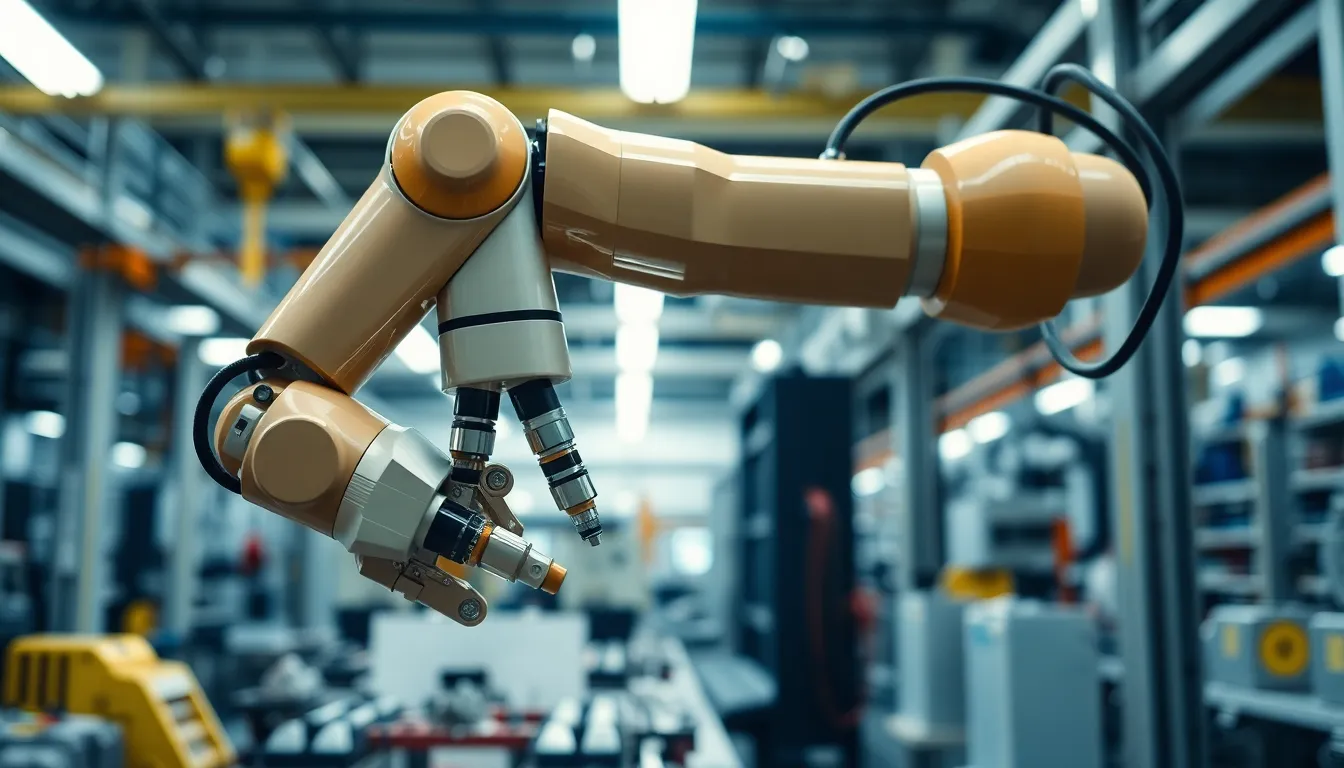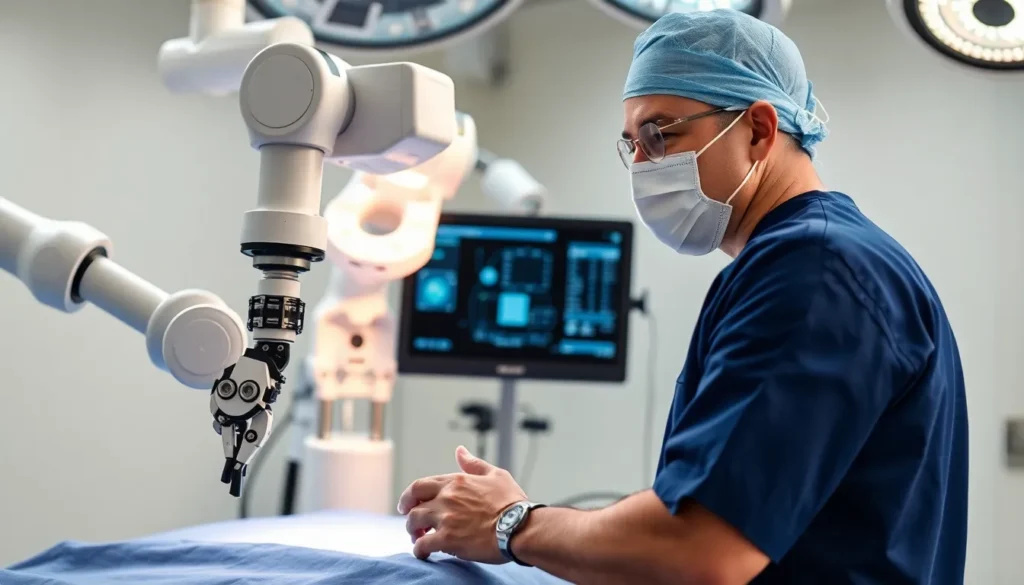Table of Contents
ToggleRobotics is no longer just a sci-fi dream; it’s a reality that’s reshaping the world as we know it. From vacuuming our floors to performing intricate surgeries, robots are stepping up their game and proving they can do more than just dance at parties. With advancements in artificial intelligence and machine learning, these mechanical marvels are becoming smarter, faster, and more capable than ever before.
Overview of Robotics Advancements
Robotic technology has rapidly evolved, transforming industries and everyday life. Innovations in artificial intelligence and machine learning significantly enhance robot capabilities. This progression allows robots to perform tasks with remarkable precision and efficiency.
Robots now assist in various sectors, including healthcare, manufacturing, and agriculture. In healthcare, surgical robots improve precision in operations, potentially reducing recovery times. Manufacturing robots streamline production processes, increasing output while minimizing human error. Agriculture benefits from autonomous machines that optimize planting and harvesting operations.
Advancements in sensor technology also contribute to robotics evolution. Sensors enable robots to perceive their surroundings, enhancing safety and responsiveness. Enhanced computer vision allows robots to navigate complex environments and perform intricate tasks.
Collaborative robots, or cobots, exemplify the trend of human-robot interaction. These robots work alongside humans, boosting productivity and creating safer work environments. Applications include assembly lines, where cobots assist with repetitive tasks, allowing humans to focus on more complex responsibilities.
Development in soft robotics introduces flexible and adaptable designs. Soft robots incorporate materials that mimic biological systems, enabling delicate handling. This capability finds use in fields like medicine, where soft robots assist in minimally invasive surgeries.
Robotics advancements continue to unfold, showcasing the potential for even more groundbreaking innovations. Continuous research and development in this field promise further integration into daily life, enhancing convenience and efficiency across multiple domains.
Key Technological Innovations

Robotics has seen numerous innovations that enhance functionality and performance. These advancements primarily focus on integrating artificial intelligence and machine learning.
Artificial Intelligence in Robotics
Artificial intelligence plays a critical role in robotics. AI algorithms enable machines to analyze vast amounts of data and make decisions in real-time. Robots equipped with AI can adapt to their environment, improving their operational capabilities. They perform complex tasks such as diagnosing medical conditions and optimizing supply chain logistics. Additionally, AI-powered robots exhibit learning products that enhance their effectiveness through experience. Healthcare applications showcase surgical robots that utilize AI for improved precision and safety.
Advances in Machine Learning
Machine learning drives significant enhancements in robotic capabilities. This technology enables robots to learn from past experiences and optimize their performance accordingly. Various algorithms allow machines to process information, identifying patterns and trends that inform actions. Robots in manufacturing benefit greatly from machine learning, as they continually refine processes to increase efficiency and reduce errors. These advancements also lead to smarter decision-making abilities in robotic systems. As they analyze data from sensors, adaptive robots can adjust operations, enhancing productivity and reliability.
Applications of Robotics Advancements
Robotics advancements are revolutionizing industries, bringing efficiency and precision to various fields. Key sectors include healthcare, manufacturing, and agriculture.
Healthcare Sector
Surgical robots significantly enhance operational precision, enabling surgeons to perform intricate procedures with improved accuracy. These systems offer surgeons enhanced control and reduce patient recovery times. Additionally, robots assist in rehabilitation by guiding patients through physical therapy exercises. Telepresence robots also facilitate remote consultations, ensuring that patients access care regardless of geographical barriers. Innovations such as robotic exoskeletons can even aid in mobility recovery for patients with physical disabilities.
Manufacturing and Automation
Robotics enhances manufacturing by streamlining processes and improving product quality. Automated assembly lines rely on industrial robots to handle repetitive tasks, optimizing production speed. Collaborative robots, or cobots, work alongside human operators, handling more strenuous tasks while boosting overall productivity. Flexibility in deployment allows manufacturers to adapt quickly to changing demands, accommodating custom orders without extensive downtime. Predictive maintenance algorithms further support operational efficiency by minimizing machine failure risks and extending equipment lifespan.
Agriculture Innovations
Agricultural robotics introduces autonomous machines that optimize planting, monitoring, and harvesting. Drones equipped with imaging technology assess crop health, allowing for targeted disease management and resource allocation. Further, robotic harvesters collect produce efficiently, reducing human labor while improving yield quality. Precision irrigation systems use robotic technology to deliver water with minimal waste, ensuring sustainable practices. Overall, these innovations transform agriculture, increasing productivity while adhering to environmental stewardship principles.
Challenges and Ethical Considerations
The rise of robotics brings significant challenges and ethical concerns that require careful consideration. Job displacement emerges as a primary issue, as automation replaces routine tasks traditionally performed by humans. Studies estimate that automation could affect millions of jobs in various sectors, raising questions about the future of the workforce.
Safety remains a critical concern, particularly in environments where humans and robots interact. Accidents involving collaborative robots highlight the need for stringent safety protocols and regulations. Ensuring that robots can operate safely alongside humans is essential for fostering trust in robotic systems.
Privacy issues also arise with increased use of robotics, especially concerning data collection and surveillance. Robots equipped with AI often gather vast amounts of data, leading to potential misuse if not handled properly. Implementing robust data protection measures is crucial for safeguarding individual privacy.
Autonomy and decision-making present additional ethical dilemmas. As robots gain capabilities to make choices, ethical frameworks must guide their actions, especially in sensitive situations like healthcare. The question of accountability also comes into play when robots make errors, necessitating clear guidelines on responsibility.
Finally, societal implications warrant attention. The integration of robots into daily life can create disparities, with access to advanced technology often limited to affluent communities. Ensuring equitable access and addressing the digital divide are essential for inclusive progress.
Continued dialogue around these ethical considerations and challenges will shape the robotics landscape. Stakeholders from various sectors must collaborate to establish standards that promote safe, responsible, and equitable robotic advancements.
Future Trends in Robotics
Anticipated robotics trends highlight increased automation across various industries. Emerging technologies like AI and machine learning significantly enhance robotics capabilities, enabling machines to operate independently. Greater flexibility in robotic design allows for the creation of adaptable systems tailored to specific tasks.
Advancements in connectivity promise smarter robots that communicate seamlessly with each other and human operators. Enhanced cloud computing capabilities facilitate real-time data sharing, improving decision-making processes. Robotics is expected to focus on user-friendly interfaces, making interactions more intuitive for non-technical users.
Healthcare robotics will continue evolving, emphasizing improved patient outcomes and personalized care. Surgical robots will incorporate AI-assisted diagnostics, allowing for higher precision during complex procedures. Telehealth applications will expand, offering remote assistance and monitoring for patients.
Manufacturing robots are anticipated to become even more collaborative. Cobots will integrate further with human teams, augmenting rather than replacing labor. Enhanced machine learning algorithms will enable these robots to adapt to various tasks and environments quickly.
Agricultural innovations will also advance, with autonomous drones optimizing farming operations. Precision robotics will enhance resource efficiency while minimizing environmental impact. Robotic solutions for harvesting, monitoring, and disease management are likely to gain traction, addressing labor shortages and increasing productivity.
Ethical considerations will shape future discussions about robotics implementation. Regulatory frameworks will emerge to address concerns about job displacement and safety. Data privacy will remain a priority, guiding the development of responsible AI and robotics practices.
Robotics advancements promise a significant impact on society, driving efficiency and innovation. As technology continues to progress, integrating ethical considerations alongside emerging capabilities will ensure a sustainable future for robotics.
The advancements in robotics are reshaping industries and everyday life in profound ways. As technology continues to evolve the integration of AI and machine learning will enhance robots’ capabilities further. This evolution promises to drive efficiency and productivity across various sectors while also addressing pressing ethical concerns.
The future of robotics holds exciting potential with increased automation and smarter systems. However the challenges surrounding job displacement and safety must be navigated carefully. By fostering responsible practices and promoting inclusive access to technology society can harness the benefits of robotics while mitigating its risks. The journey ahead is one of innovation and responsibility as robotics continues to redefine what’s possible.







